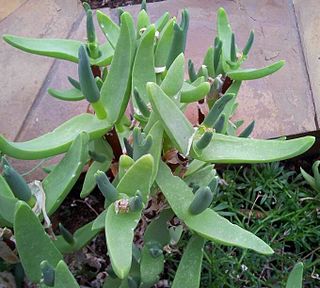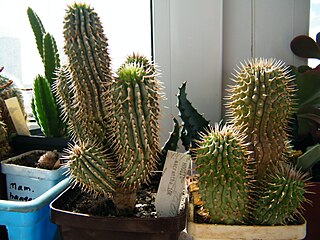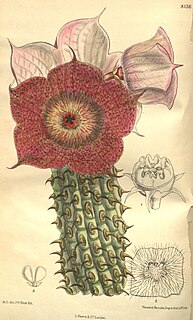
Apocynaceae is a family of flowering plants that includes trees, shrubs, herbs, stem succulents, and vines, commonly known as the dogbane family, because some taxa were used as dog poison. Members of the family are native to the European, Asian, African, Australian, and American tropics or subtropics, with some temperate members. The former family Asclepiadaceae is considered a subfamily of Apocynaceae and contains 348 genera. A list of Apocynaceae genera may be found here.

Hoodia is a genus of flowering plants in the family Apocynaceae, under the subfamily Asclepiadoideae, native to Southern Africa.

Hoodia gordonii, also known as Bushman's hat, is a leafless spiny succulent plant supposed to have therapeutic properties in folk medicine. It grows naturally in Botswana, South Africa and Namibia. The species became internationally known and threatened by collectors, after a marketing campaign falsely claimed that it was an appetite suppressant for weight loss. The flowers smell like rotten meat and are pollinated mainly by flies. The indigenous San people of the Namib desert call this plant ǁhoba – and the Afrikaans name ghaap is used to refer to all species of Hoodia.

Hoodia juttae is a species of plant in the family Apocynaceae. It is endemic to Namibia. Its natural habitats are rocky areas and cold desert. H. juttae is found around the Little and Great Karas mountains. It is threatened by collection. The plant was discovered by Jutta Dinter, the wife of botanist, Kurt Dinter in 1913. The scientific name refers to Jutta.

Hoodia ruschii is a species of stem succulent plant in the family Apocynaceae. It is endemic to Namibia. Its natural habitats are rocky areas and cold desert.
Hoodia triebneri is a species of plant in the family Apocynaceae. It is endemic to Namibia. Its natural habitat is rocky areas, especially underneath Acacia trees and below ridges.

Hylotelephium spectabile is a species of flowering plant in the stonecrop family Crassulaceae, native to China and Korea. Its common names include showy stonecrop, iceplant, and butterfly stonecrop.

In botany, succulent plants, also known as succulents, are plants with parts that are thickened, fleshy, and engorged, usually to retain water in arid climates or soil conditions. It is a characteristic that is not used scientifically for the definition of most families and genera of plants because it often can be used as an accurate characteristic only at the single species level. The word succulent comes from the Latin word sucus, meaning 'juice', or 'sap'. Succulent plants may store water in various structures, such as leaves and stems. The water content of some succulent organs can get up to 90–95%. Some definitions also include roots, thus geophytes that survive unfavorable periods by dying back to underground storage organs may be regarded as succulents. In horticultural use, the term succulent is sometimes used in a way that excludes plants that botanists would regard as succulents, such as cacti. Succulents are often grown as ornamental plants because of their striking and unusual appearance, as well as their ability to thrive with relatively minimal care.

AnacampserosL. is a genus comprising about a hundred species of small perennial succulent plants native to Southern Africa, Ethiopia and Latin America. The botanical name Anacampseros is an ancient one for herbs supposed to restore lost love.

Lewisiopsis tweedyi is a flowering plant and sole species in genus Lewisiopsis. The species, formerly known as Cistanthe tweedyi and Lewisia tweedyi, is now classified in the family Montiaceae. The plant is known by the common names Tweedy's pussypaws, Tweedy's lewisia, or Tweedy's bitterroot. It is endemic to western North America in north-central Washington and adjacent British Columbia. It commonly grows on well-drained slopes often on rocky slopes or in rock crevices from low elevation ponderosa pine sites up to the drier part of the Grand Fir zone of the North Cascades. The flowers usually have a coral, apricot, or pink color.

Crassula muscosa, synonyms Crassula lycopodioides and Crassula pseudolycopodioides, is a succulent plant native to South Africa and Namibia, belonging to the family of Crassulaceae and to the genus Crassula. It is a houseplant grown worldwide and commonly known as rattail crassula, watch chain, lizard's tail, zipper plant and princess pines.
Hoodia flava is a succulent native to the Cape Province in South Africa and to Namibia. It has a unique pattern of distribution, growing inside bushes or on gravelly slopes and hills. It is commonly known as ghaap or yellow-flowered ghaap in the Afrikaans language.

Crassula ovata, commonly known as jade plant, lucky plant, money plant or money tree, is a succulent plant with small pink or white flowers that is native to the KwaZulu-Natal and Eastern Cape provinces of South Africa, and Mozambique; it is common as a houseplant worldwide. Much of its popularity stems from the low levels of care needed; the jade plant requires little water and can survive in most indoor conditions. It is sometimes referred to as the money tree; however, Pachira aquatica also has this nickname.

Mitrophyllum is a genus of succulent plants of the family Aizoaceae, indigenous to the arid region around the Richtersveld, on the border of South Africa and Namibia.

Piaranthus is a succulent plant genus in the subfamily Asclepiadoideae, in the family Apocynaceae.

Ceraria namaquensis, with the common names Namaqua porkbush and Namaqua portulacaria, is a species of succulent shrub, native to the border between South Africa and Namibia.

Ipomoea oenotherae is a species of plant of the morning glory genus, Ipomoea, in the family Convolvulaceae. It derives its name from the resemblance it bears to plants in the genus Oenothera. Ipomoea oenotherae is a succulent and a cryptophyte.

Hoodia officinalis is a succulent plant native to Namibia and the Cape Province of South Africa. H. officinalis has two officially recognized subspecies, H. officinalis subsp. officinalis and subsp. delaetiana, which are identified mainly by their distribution. Subsp. delaetiana grows only in the Klinghardt Mountains and are larger than subsp. officinalis.

Hoodia macrantha is a succulent plant native to Namibia and the Cape Province of South Africa. It is regarded by some sources as a synonym of the accepted name for the plant, Hoodia currorii subsp. currorii.

Hoodia currorii is a succulent plant native to Namibia and the Cape Province of South Africa. It grows in desert areas and is common along the road from Karibib to Swakopmund in Namibia. It is also known as ghaap in the vernacular.

















